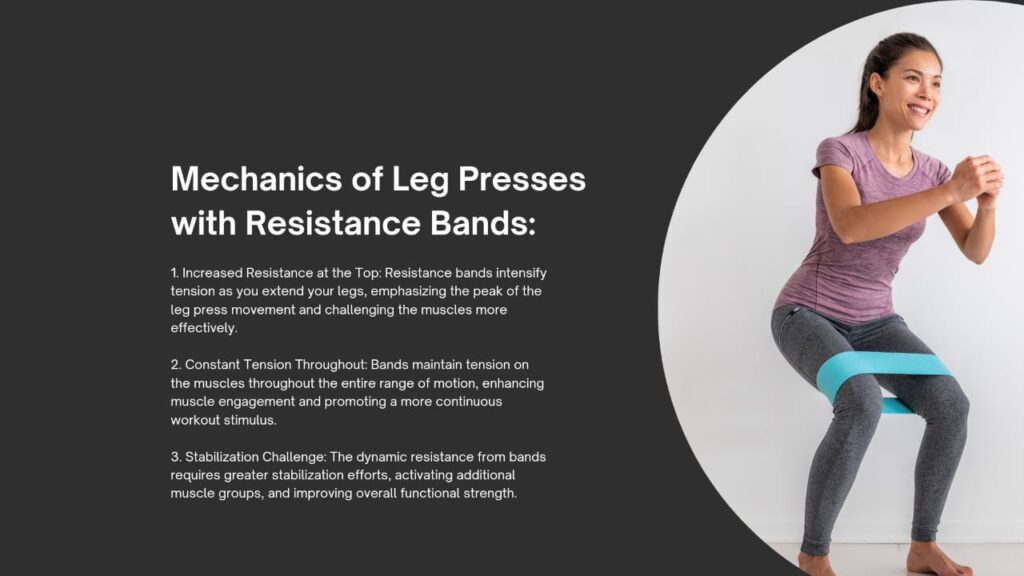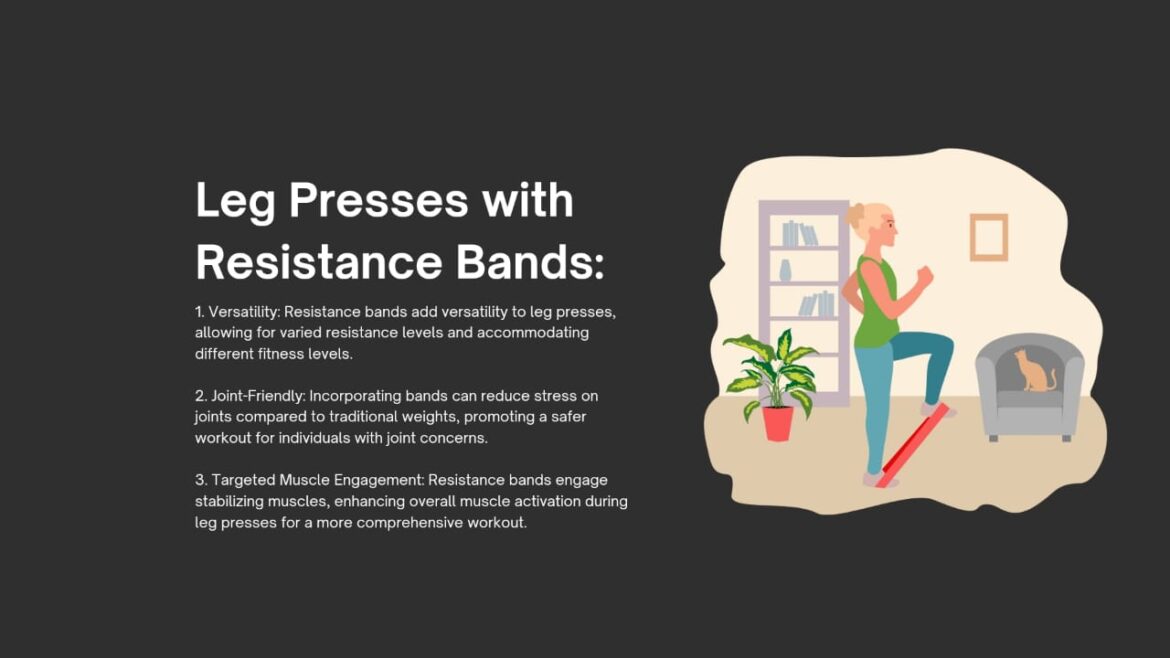Leg presses with resistance bands offer an active and flexible alternative to regular weightlifting exercises. This workout increases strength, stability, and muscle mass by merging the benefits of resistance bands with the select muscle session of leg presses. It suits many fitness levels and gives a selective yet flexible way to build lower-body strength and better overall fitness.
Leg Strength:
Leg strength is major for many physical activities, from walking and running to jumping and lifting. Strong legs give a stable base for the body and help stop cuts. Exercises like squats, lunges, and leg presses target key muscle groups such as the quadriceps, hocks, and calves, boosting overall leg strength and functional fitness.
Introduction:
In the land of strength training, leg exercises hold supreme importance. Among the infinite methods available, leg presses with resistance bands are a flexible and effective way for building lower-body strength and muscle mass. This article delves into the benefits, differences, and tips for including leg presses with resistance bands in your fitness training.
Understanding Leg Presses with Resistance Bands:
Leg presses with resistance bands require the blending of regular leg press exercises with the added resistance given by elastic bands. This merger boosts the selection of the muscles implicated, especially the quadriceps, hamstrings, glutes, and calves.
By using resistance bands, individuals can engage in a vital form of resistance training that increases muscle mass and promotes practical strength gains.

What are leg presses doing?
Leg presses first select the lower body’s muscles, especially the quadriceps, hamstrings, and glutes. When performing leg presses, the quadriceps muscles at the front of the thigh flex the knee joint, while the hocks at the back of the thigh help balance and support the movement.
Plus, the back is a trip to help push the weight away from the body. This exercise helps to brace these muscle groups, improve lower-body strength, and increase overall lower-body muscular stability. Moreover, leg presses can also aid in growing balance and unity, making them a valuable addition to any lower-body workout routine.
Mechanics of Leg Presses with Resistance Bands:
To perform leg depression with resistance bands, one usually uses a leg press tool or a stable surface for support. The resistance bands are attached to the platform of the leg press tool and then wind around the foot or ankle, giving tension throughout the movement.
As the legs expand against the resistance, the bands boost the workload on the selected muscles, creating a more demanding and adequate exercise.

Benefits of Incorporating Resistance Bands:
There are many benefits to resistance bands, but some of them are given below:
Increased muscle activation:
Resistance bands add an object of insercity, forcing the muscles to work harder to balance the movement, thus leading to greater muscle start.
Versatility:
Leg presses with resistance bands offer a huge range of resistance levels, making them balanced for people of all fitness levels.
Joint-Friendly:
Unlike heavy weights, resistance bands give a smooth and managed resistance that is kind to the joints, decreasing the risk of cuts.
Portable and affordable:
Resistance bands are lightweight, compressed, and cost-effective, making them a suitable option for home workouts or travel.
Improved Balance and Coordination:
The insecurity introduced by resistance bands requires muscle sense and increases balance and coordination.

Variations of Leg Presses with Resistance Bands:
Single-Leg Press:
Execute the leg press with one leg at a time to separate each leg and correct muscle variance.
Sumo Leg Press:
Place the feet wide apart and turn them outward to select the internal thighs and buns.
Elevated Leg Press:
Raise the heels on a step or platform to expand the range of motion and weight the quadriceps.
Tempo Leg Press:
Slow down the strange (lowering) part of the movement to expand time under tension and brace muscle growth.
Plyometric Leg Press:
Add a great jump at the top of the leg press motion to increase power and agility.

Tips for optimal performance:
Maintain proper Form:
Keep the back bland, knees aligned with the toes, and heels grounded all over the motion.
Control the Resistance:
Focus on managing the motion both on the parallel (lifting) and strange (lowering) parts to maximize the muscle session.
Gradually increasing resistance:
Start with lighter resistance bands and usually progress to heavier ones as your power improves.
Incorporate Variety:
Trial with different foot placements, tempos, and rep ranges to constantly select your muscles and stop plateaus.
Listen to your body:
Pay attention to any signs of gyp or pain and adjust the resistance or methods suitable to avoid cuts.
Incorporating Leg Presses with Resistance Band into Your Routine:
To reap the full advantages of leg presses with resistance band, consider combining them into your live workout routine. Aim to perform 2-3 sets of 8–12 recaps, focusing on maintaining proper form and selecting yourself with increasing resistance. You can include into leg day workouts or as part of a full-body power training routine.

Conclusion:
Leg presses with resistance band offer an active and effective way to increase lower body power, muscle mass, and functional fitness. By understanding the technicals, benefits, differences, and tips for optimal performance, you can include this flexible exercise in your training to achieve your strength and fitness goals.
If you’re a novice or a seasoned racer, leg presses with resistance band provide a select and rewarding workout experience that can take your leg training to the next level.
FAQS:
What are leg presses with resistance bands?
How do you perform leg presses with resistance bands?
Fix resistance bands to a stable moor, loop them around the leg, press footplate, and press away, Operate muscles with added resistance
